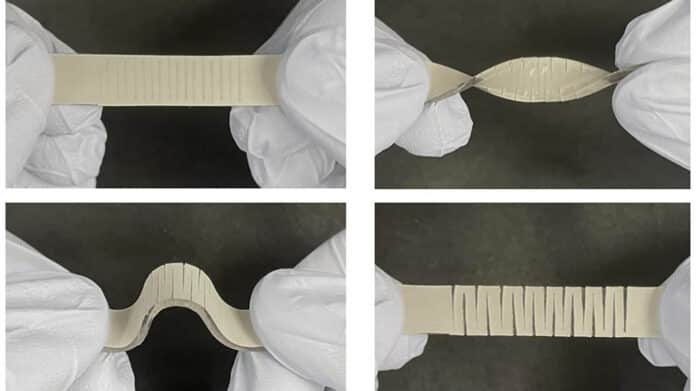Soft and stretchable strain sensors have been attracting significant attention. However, the trade-off between the sensitivity and the sensing range has been a major challenge.
Researchers at North Carolina State University have developed a soft stretchable strain sensor that has an unusual combination of high sensitivity, large sensing range, and high robustness, allowing it to detect even minor changes in strain with a greater range of motion than previous technologies.
Strain is a measurement of how much a material deforms from its original length. Strain measurement is useful in applications such as devices that measure blood pressure or physical movement. However, sensitive strain sensors capable of detecting small deformations cannot be stretched very far. On the other hand, sensors that can be stretched to greater lengths are usually not very sensitive.
“The new sensor we’ve developed is both sensitive and capable of withstanding significant deformation,” says Yong Zhu, corresponding author of a paper on the work. “An additional feature is that the sensor is highly robust even when over-strained, meaning it is unlikely to break when the applied strain accidentally exceeds the sensing range.”
The new sensor is made of a silver nanowire network embedded below the surface of an elastomer polymer strip. The polymers feature a series of parallel cuts of a uniform depth into the sides of the sensor, alternating from either side of the material – one cut from the left, followed by one from the right, followed by one from the left, and so on. The patterned cuts enable a greater range of deformation without sacrificing sensitivity.
The strain sensor works by measuring changes in an electrical resistance – as the material stretches, resistance increases. The cuts in the surface of the sensor are perpendicular to the direction that it is stretched. This cut allows the sensor to deform significantly. When the sensor is stretched or twisted, those cuts in the surface pull open, creating a zigzag pattern. This allows the device to be stretched to a much longer length without reaching the breaking point. At the same time, when the cuts pull open, this forces the electrical signal to travel further, traveling up and down the zigzag.
The researchers demonstrated the sensor’s utility by creating new health monitoring and human-machine interface devices. The stretchable strain sensor can be integrated into wearable systems for monitoring physiological functions and body motions associated with different levels of strain, such as blood pressure and lower back health. Finally, a soft three-dimensional (3D) touch sensor that tracks both normal and shear stresses is developed for human-machine interfaces and tactile sensing for robotics.
“The sensor can be easily incorporated into existing wearable materials such as fabrics and athletic tapes, convenient for practical applications,” Zhu says. “And all of this is just scratching the surface. We think there will be a range of additional applications as we continue working with this technology.”
Journal reference:
- Shuang Wu, Katherine Moody, Abhiroop Kollipara, and Yong Zhu. Highly Sensitive, Stretchable, and Robust Strain Sensor Based on Crack Propagation and Opening. ACS Applied Materials & Interfaces, 2022; DOI: 10.1021/acsami.2c16741
